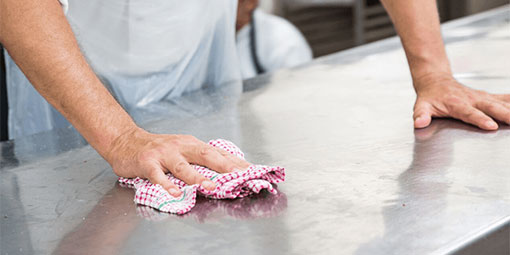When preparing food for those affected by the recent bushfires there are preventable steps you can take to avoid a food safety incident.
The four key steps in safe food handling: clean, separate, cook, and chill all food.
Wash and dry your hands thoroughly with soap using clean, drinking-quality water.
Washing hands before preparing food, after handling raw meat and chicken, cooked food and eggs, after blowing your nose, coughing, sneezing and after toilet use and cleaning-up.
There is so much that goes on in your kitchen on any given day and just because the kitchen looks clean doesn’t mean that it’s free of potential food borne illness. Food poisoning is caused by microscopic bacteria that are invisible to the naked eye. It is important that even though benches and dishes look clean, that they are properly rinsed with hot water (check the rinse temperature of your dishwasher) before food preparation takes place and that food is properly cleaned and handled before preparing.
Fruits and vegetables are an important part of a healthy diet. But just like other foods they carry a risk of food borne illness. Always rinse produce under running tap water, including fruits and vegetables with skins and rinds that are not eaten. Never use detergent or bleach to wash fresh fruits or vegetables as these products are not intended for consumption.
Bacteria can survive freezing and cooking temperatures. Freezing food is not a method for making foods safe to eat. When food is thawed, bacteria can still be present and may begin to multiply. The only way to kill harmful bacteria is to cook food above 60°c and measure the internal temperature with a clean and sanitised probe thermometer.
Ready to eat food that don’t need any further cooking and food that provide a place for bacteria to survive and grow are high–risk foods. Examples of high–risk foods include: raw and cooked meat, chicken, fish and shellfish, cooked rice, eggs, dairy products, soup, casseroles, pasta dishes and sandwiches with various meat fillings.
Food will cool faster in smaller shallow based containers. The temperature needs to drop from 60ºC to 21ºC in 2 hours and then from 21ºC to 5ºC in a further 4 hours. In practice, it is best to leave hot food at room temperature for a short period of time and if necessary stir the food to release the heat from the product before putting it in to the cool room or fridge. Measure the internal food temperature with a probe thermometer.
When transporting food, it is important to protect food from contamination by keeping it covered at all times. Remember to keep cold food cold (i.e. below 5°c). Place cold food in a eski or cooler with ice or frozen gel packs.
Images: Amanda Kelly Photography and Testo Australia.
Want further information? Contact Andrew Thomson 0422285720 or info@thinkstsolutions.com.au
Think ST Solutions helps protect and grow food business through innovation and risk reduction strategies.

